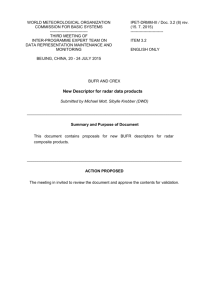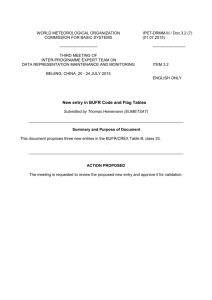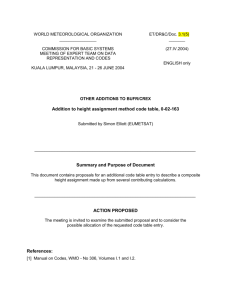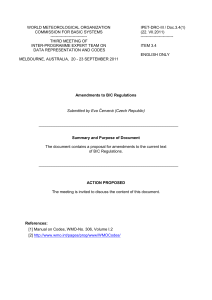Doc. 3.5.5(1)Rev1
advertisement
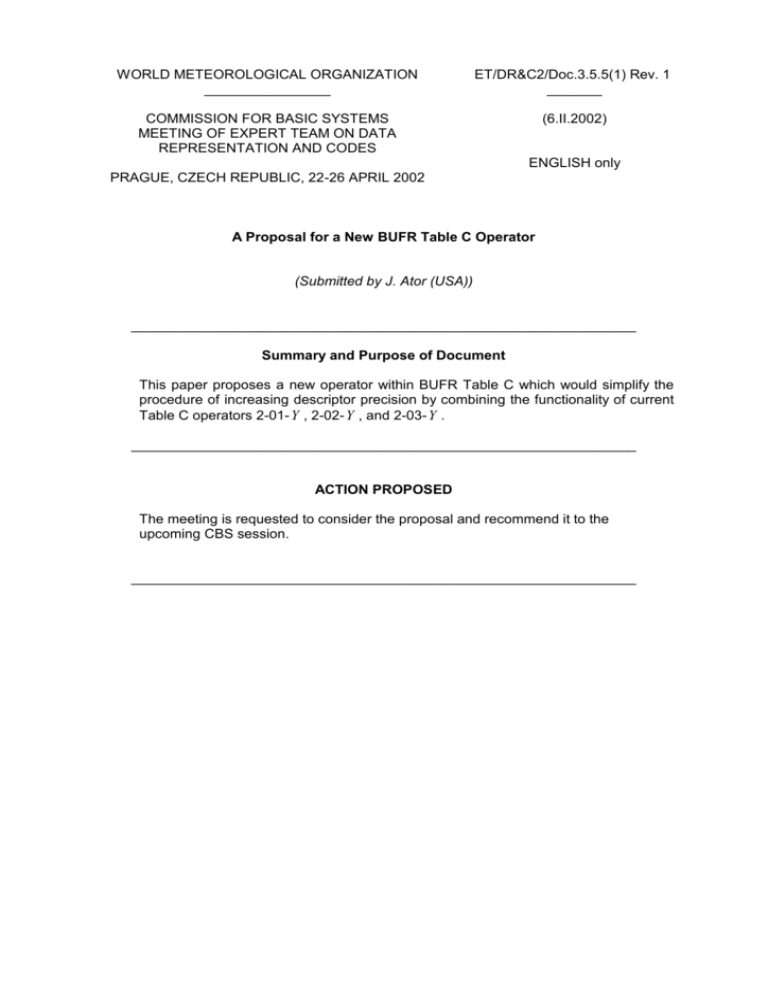
WORLD METEOROLOGICAL ORGANIZATION ________________ ET/DR&C2/Doc.3.5.5(1) Rev. 1 _______ COMMISSION FOR BASIC SYSTEMS MEETING OF EXPERT TEAM ON DATA REPRESENTATION AND CODES (6.II.2002) ENGLISH only PRAGUE, CZECH REPUBLIC, 22-26 APRIL 2002 A Proposal for a New BUFR Table C Operator (Submitted by J. Ator (USA)) ________________________________________________________________ Summary and Purpose of Document This paper proposes a new operator within BUFR Table C which would simplify the procedure of increasing descriptor precision by combining the functionality of current Table C operators 2-01- Y , 2-02- Y , and 2-03- Y . ________________________________________________________________ ACTION PROPOSED The meeting is requested to consider the proposal and recommend it to the upcoming CBS session. ________________________________________________________________ ET/DR&C2/Doc.3.5.5(1) Rev. 1, p. 2 DISCUSSION 1. When it is desired to increase the precision of a BUFR Table B descriptor, the Table C operator 2-02- Y is used to indicate the new scale factor to be used when encoding the actual value into BUFR. However, the use of this operator often necessitates corresponding changes to the reference value (when non-zero) and bit width of the Table B descriptor in question, in order to be able to represent the same range of actual values with the new precision. This is especially true for the reference value, since it normally has the original scale factor already “built-in” to it; thus, when this scale factor is increased, the reference value often must be modified accordingly. Herein lies a non-trivial difficulty, because the rules for changing a reference value, as defined for Table C operator 2-03- Y , involve storing the new reference value not within the Data Description section, but, rather, within the Data section itself. Thus, an enduser of the same BUFR message must necessarily, in order to be able to fully parse the Data Description section, prematurely jump ahead to the Data section in order to obtain the necessary information, an action which seems, at best, counter-intuitive. In fact, one could argue that this inherent complexity is likely the main reason why such little actual use seems to be made of this 2-03- Y operator, whereas the use of operators 2-01- Y and 2-02- Y is much more widespread. 2. With this in mind, we propose a new BUFR Table C operator which would effect an increase of scale in the same manner as 2-02- Y , except that it would also automatically effect a corresponding increase of scale to the associated reference value, and thereby obviate the need to define the new reference value using the additional (and more complex!) 2-03- Y operator. Taken one step further, since, again, a corresponding increase of bit width is usually also necessary when increasing a scale, this new operator could also be made to automatically effect a sufficient bit width increase based upon the desired increase of scale, so that this one new operator then accomplishes the same amount of work that currently requires the separate use of all three operators 2-01- Y , 2-02- Y , and 2-03- Y ! At any rate, since the main goal of this proposal is, again, to simplify the changing of reference values that often accompanies an increase in scale, and since CREX does not even make use of reference values, there should be no need to add a corresponding new operator to CREX Table C. Put another way, the two existing CREX Table C operators C-01- Y and C-02- Y should remain entirely sufficient (and straightforward enough!) for any desired precision increase to any CREX Table B descriptor. Proposed Modifications 3. We propose the following new BUFR Table C operator descriptor: Table Reference: 2-07- Y Operator Name: Increase scale, reference value and data width Operator Definition: For Table B elements which are not CCITT IA5 (character data), code tables, or flag tables: 1. Add Y to the existing scale factor ET/DR&C2/Doc.3.5.5(1) Rev. 1, p. 3 2. Multiply the existing reference value by 10Y . 3. Add ( 10 Y + 2) 3 bits to the existing bit width. Note that this expression should be evaluated using integer division (ie. as an integer divided by integer 3) in order to ensure uniformity of results across various computer platforms. and the rewording of Notes to BUFR Table C as follows: (1) The operations specified by operator descriptors 2 01, 2 02, 2 03, 2 04, and 2 07 remain defined until cancelled or until the end of the subset. (4) Nesting of operator descriptors must guarantee unambiguous interpretation. In particular, operators defined within a set of replicated descriptors must be cancelled or completed within that set, and the 2 07 operator may not be nested within any of the 2 01, 2 02, and 2 03 operators, nor vice-versa. 4. The following discussion describes the derivation of the above formula for modifying the bit width: If we assign: s0 = old scale factor r 0 = old reference value b0 = old bit width s1 = new scale factor r 1 = new reference value b1 = new bit width then the upper bound of actual numbers that we can encode (including the “missing” value) using the old and new values, respectively, are ( 2b0 - 1+ r 0 ) 10 s0 and ( 2b1 - 1+ r 1 ) 10 s1 . Now, we want to ensure that ( 2b0 - 1+ r 0 ) 10 s0 ( 2b1 - 1+ r 1 ) 10 s1 and solving this inequality for b1 yields b1 ln ((( 2b0 - 1 + r 0 ) 10 s0 10 s1 ) - r 1 + 1) ln (2) However, by definition, we also know that s1 = s 0 + Y and Y r 1 = r 0 10 , which, via substitution and simplification, allows us to rewrite the above inequality as Y b1 ln (( 2b0 - 1) ( 10 ) + 1) ln (2) Now, the above expression, being solely a function of the old bit width and the desired increase in scale, seems simple enough to implement in practice, and we can always round the result ET/DR&C2/Doc.3.5.5(1) Rev. 1, p. 4 upward to the next largest integer (using, e.g. the “ceiling” function); therefore, at least at first glance, it appears that we have a workable formula for determining b1 . However, the computed result will always be a real number, and therefore we must remain mindful of the issues relating to floating-point representation on computer systems. Specifically, suppose that a particular pair of Y and b0 values yielded a computed result that was very close to an integer. Could we guarantee that we would always get the same result on any two computers running anywhere in the world? As an example, suppose that, for a particular case, one computer obtained a result of 20.001 and another obtained a result of 19.999? Then, applying the “ceiling” function in each case would yield two different values of 21 and 20, respectively, for b1 ! Obviously, we want to avoid such a situation at all costs in order to maintain the machine-independent nature of BUFR, so it seems then that we must resort to a different approach in order to guarantee that two computers running anywhere in the world for any particular pair of Y and b0 values always obtain the same result for b1 . In practice, this turns out to be more straightforward than one might think! To see this, first of all note that ln (( 2b0 - 1) ( 10Y ) + 1) < ln (( 2b0 ) ( 10Y ) + 1) Also, note that, for any real and positive X , it is true that lim ( ln (X + 1) - ln (X)) = 0 X Therefore, for any Y and b0 , we can redefine the upper bound b1 via the inequality Y b1 ln (( 2b0 ) ( 10 )) ln (2) = ln ( 2b0 ) ln (2) + ln ( 10Y ) ln (2) = b0 + (Y) ( ln (10) ln (2)) Or, written another way, ( b1 - b0 ) (Y) ( ln (10) ln (2)) In other words, the required increase in bit width is always an upper bound to the increase in scale multiplied by the constant ( ln (10) ln (2)) . A rather straightforward computer simulation lends further proof to this assertion while also showing that, for each increase of scale represented in the first column below, the corresponding increase of bit width in the second column is always sufficient for every possible b0 : 1 4 2 7 3 10 4 14 5 17 ET/DR&C2/Doc.3.5.5(1) Rev. 1, p. 5 6 7 8 9 10 20 24 27 30 34 The above table covers all but the most extreme cases and could be published as a look-up table within the BUFR regulations, thereby ensuring that any BUFR encoder/decoder programs running anywhere in the world always utilized the same increase in bit width for a given increase in scale. However, there is an even better way which allows the above table to be extended for any theoretical increase of scale but which at the same time avoids any of the aforementioned pitfalls of differing floating-point representation schemes. Namely, if we let n represent the first column above, then, the second column is given by (10 n + 2) 3 when computed using integer division. _____________________

